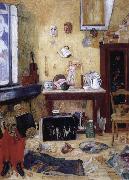Wholesale Oil Painting No Minimum |
|||||||||||
|
|
|||||||||||

|
|||||||||||
|
|
|
||||||||
James EnsorBelgian 1860-1949 Belgian painter, printmaker and draughtsman. No single label adequately describes the visionary work produced by Ensor between 1880 and 1900, his most productive period. His pictures from that time have both Symbolist and Realist aspects, and in spite of his dismissal of the Impressionists as superficial daubers he was profoundly concerned with the effects of light. His imagery and technical procedures anticipated the colouristic brilliance and violent impact of Fauvism and German Expressionism and the psychological fantasies of Surrealism. Ensor most memorable and influential work was almost exclusively produced before 1900, but he was largely unrecognized before the 1920s in his own country. His work was highly influential in Germany, however: Emil Nolde visited him in 1911, and was influenced by his use of masks; Paul Klee mentions him admiringly in his diaries; Erich Heckel came to see him in the middle of the war and painted his portrait (1930; Cologne, Wallraf-Richartz-Mus.); Alfred Kubin owned several of his prints, while Marc Chagall and George Grosz also adapted certain elements from Ensor. All the artists of the Cobra group saw him as a master. He influenced many Belgian artists including Leon Spilliaert, Rik Wouters, Constant Permeke, Frits van den Berghe, Paul Delvaux and Pierre Alechinsky. |
||||||||
|
|
||||||||
Skeleton i the studio
Skeleton i the studio Painting ID:: 37502 |
mk1260
1900
Here,as in skeletons trying to warm themselves of 1889,we are in the artist-studio.this time,however,the space is not bare,but full of masks,curios,books,palettes,utensils,folders full of painting,and even a coffee grinder sitting on a perfectly ordinary chair.
mk1260 1900 Here,as in skeletons trying to warm themselves of 1889,we are in the artist-studio.this time,however,the space is not bare,but full of masks,curios,books,palettes,utensils,folders full of painting,and even a coffee grinder sitting on a perfectly ordinary chair. |
|||||||
|
CONTACT US |

